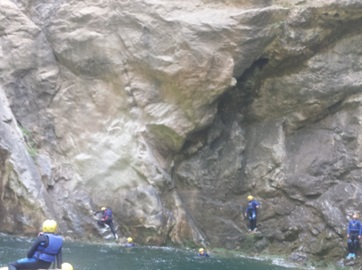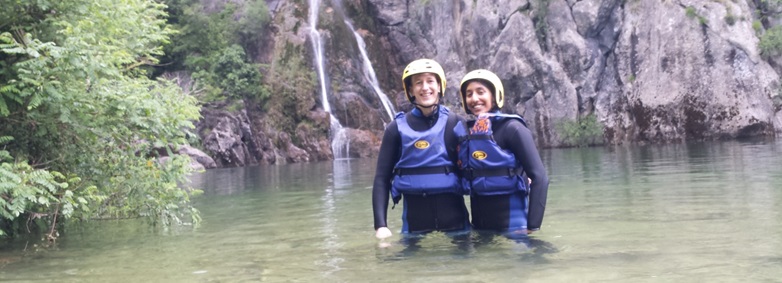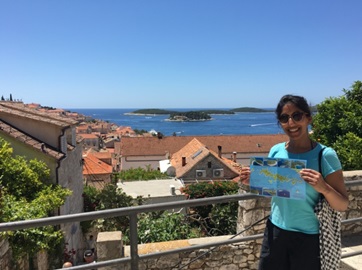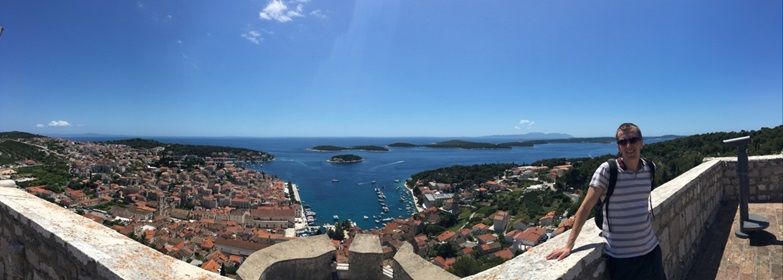Croatia Adventure Week (Split and Hvar)
Split is the largest city on the Adriatic coast and second largest in Croatia with just over 200,000 permanent residents. It is steeped in culture and history having been under Roman, Venetian, Austrian, French, Italian and Yugoslav control at different points in time and a large part of the city is now designated as a UNESCO-World Heritage Site. Diocletian's Palace is the jewel in the crown of Split's history and key to understanding how the city developed. Diocletian's Palace was originally built as a retirement residence for Roman emperor Diocletian and was then used as a holiday home for other Roman emperors following Diocletian's death. As Split was largely built out around the palace, all of the streets and settlements are distinctly Roman-styled with a very Mediterranean feel. There are a vast array of activities available from Split with the highlights being canyoning, white water rafting and sea kayaking, plus a couple of bits of sightseeing that should not be missed - Diocletian's Palace and the high viewpoint atop the nearby hill just to the west of Split in Marjan national park. The City's coves also accommodate several blue flag beaches, which provide a perfect way to unwind between activity days.
Transport to Split
There are regular flights to Split International Airport from most major European cities. It is best served by EasyJet from London but there are also regular flights from other airlines such as Australian Airlines, Croatian Airlines, eurowings, Finnair, Lufthansa and Smart Wings, amongst others. Flights also depart from Manchester and Bristol albeit less frequently. The flight time from London to Split is around 2 hours. We would recommend checking www.skyscanner.net for the latest information.
Split Airport is about 18 miles or 30 minutes west of Split, past a series of towns known as Kastela and in close proximity to the beautiful historic town and harbour of Trogir. The quickest and most affordable way of getting from the airport to the centre of the City is the airport bus, which departs immediately outside the main terminal building of Split Airport and travels to the bus station by Split harbour virtually in the centre of the City. Tickets are 30 Kuna (£3) per person one way with journey time around half an hour. The local bus numbers 37 and 38 also go from the airport to Split but with other stops in between and arrive at another bus station that is not in the centre of town. If the timings works out (which they should do given bus departures are deliberately timed to coincide with flight landing times) the airport bus is the best option and virtually the same price. The bus station in Split is right next to the ferry and catamaran port, so if you're going straight from Split to one of the Dalmatian islands it all works very smoothly.
The alternative is of course to take a taxi, which will cost 250-300 Kuna (£25-30) with journey time also around half an hour. Bear in mind that due to some of the streets in Split being very narrow, depending on where you are staying, the taxi may not be able to drop you right in front of your accommodation, but it should be able to leave you no more than 100 yards or so away. Most accommodation is within easy walking distance of the centre of town but if you're a little further or you're tired after travelling, there are rickshaws (three wheeled bicycles that can take customers and luggage) operating across the front of the harbour who will be happy to help if you are one or two people. They will initially quote a high price but will come down by more than half if you suggest something more sensible. Alternatively, or for groups of three or more, consider taking the airport bus to the main bus station then a taxi from there to your accommodation.
Accommodation in Split
There are a vast array of accommodation options in Split. If you're looking to book an organised trip including accommodation and activities Exodus and Explore! are two good companies to consider. When we travelled we decided to self-arrange our accommodation and activities so we could tailor our tour to exactly what we wanted to do. If you're looking to do the same www.booking.com is the best choice. Make your selections based on those apartments with the best customer reviews - even if you're on a low budget there are some very well-reviewed 4 bedroom apartments for around the equivalent of £30 per night. We stayed at the 'Classy Apartment Centre' for our first 3 nights in Split then 'Apartment Adriatic' for our final night in Split following return from Hvar, both of which were excellent. There is also quite a large 3D map of the centre of Split at the harbour front (just before the right turn that leads to the front of the harbour masters) which is handy for getting your bearings and trying to pick out your own accommodation.
Food and Drink in Split
Food
There are a vast array of cafes, bars, restaurants and fast food and takeaway eateries in the centre of Split. Choose Chops Grill if you're looking for up-market and very tasty steak and seafood with prices still very reasonable compared to the UK with two main courses - fillet steak and fish fillets - with chips and drinks coming in at about the equivalent of £35. Alternative, for a quick and cheap eat - but still some of the best pizza I have ever tasted - try Planet pizza on the harbour end of Marmontova Street. Planet Pizza sells pizza in large individual slices for 10 Kunas (£1) per slice and 3-4 slices per person is ample even for big eaters. Other good options include Perivoj for Mediterranean/European food or Bokeria for its excellent wine bar, whilst the Bota Oyster & Sushi Bar is very well reviewed if you're into sea food.
Drinks and Entertainment
Some of the best spots for evening entertainment after eating are up the smaller roads and alleys throughout Split. Our favourite spot was between Bili San ice cream bar and the To Je Jo bar just off Marmontova Street (see map pictured) and looking at Trip Advisor many other visitors thought the same. The home made ice cream from Bili San is to die for and To Je Jo had some really good live music on every night we were there. The obvious choice for atmosphere and views over the bay is one of the bars along the promenade, known locally as the Riva (meaning along the shore). The Riva often feels like one giant cafe given the seemingly endless stretch of outdoor seating in front of the series of bars, restaurants and cafes along the bay. Alternatively, try the Cafe Bar Paradiso at 4 Kamila Toncica street which is positioned in a stunning courtyard featuring a number of cafe bars, which also makes a great place for a morning coffee of afternoon snack. If you head to the Bacvice Beach and keep walking you'll eventually find a number of cafes and restaurants which can be more lively. Our recommended (non-alcoholic) drink to try in Croatia is a chilled "limunada" - meaning lemonade but more like a homemade citron presse.
Brief History of Split
The first settlement in Split was by the Greeks in the 3rd and 4th century AD. The famous Diocletian Palace development then came in 295 AD when the Roman emperor ordered the palace to be built for his retirement. Split was chosen because of the beauty of the location and proximity to the nearby Roman settlement of Salona (present day Solin) just 3-4 miles away. The palace took 10 years to build and Diocletian lived there until his death in 313 AD. After this time, subsequent roman emperors continued to use the palace as a holiday home but by the late 500s AD it started to fall into disrepair. When the Roman colony of Salona was abandoned in the 7th century, many inhabitants fled to the Palace and their families continued to live there well into the second millennia. Split grew significantly during and after the 11th century before being conquerered by the Venetians in 1420. After the fall of Venetian rule in 1797, Split was ruled by the Austrians, French, Serbs, Croats and Slovenes and Italians. It was liberated from Italian rule in 1943 following the capitulation of Italy. Following a brief occupancy by Germany during the second World War, it was liberated again in 1944 when the first people’s government of Croatia was formed. During the mid to late 1900s Split had a strong manufacturing and ship-building presence but is now heavily reliant on tourism.
Activities in Split
Canyoning
Canyoning in Split involves lowering yourself into rapids at various points along the stream, interspersed with exhilarating rock jumps, short sections of rocks walking routes, a little bit of swimming and the opportunity to claw your way along the rocks to stand inside a waterfall (requires a certain degree of fitness and grip strength but well worth the effort if you can make it). Canyoning from Split is done in the Cetina canyon, around a 45 minute transfer by car or minibus from the centre of Split. Over thousands of years the Cetina canyon has been naturally moulded by the river into mystical shapes with a number of stunning waterfalls on the way down - which are of course bypassed for the purposes of the canyoning experience! The water is very clean and crystal clear offering a true experience of untouched nature with cliffs up to 180 meters high, waterfalls, lakes and subterranean tunnels.

We booked in advance with Adventure Dalmatia who we would recommend but there are lots of similar companies you can book with locally that do the same thing. Regardless of who you go with, all equipment is provided, including wet suits, life jacket and helmet. The water temperature in June was pleasant with a wetsuit, but would have felt cold without (it's cooler than the sea). The descent into the canyon is pretty steep, rocky and slippy in places - so a degree of adventure required to enjoy it - but as you descend into the canyon and the sound of the river gets louder, the excitement certainly builds. The distance from start to finish is 2,300 metres with change in altitude of 73 metres for the 'standard' canyoning option. You can also choose to opt for 'extreme canyoning' which does some slightly higher jumps, abseiling, faster rapids and more extreme rock walks.

White Water Rafting (Cetina River)
One of the must-do activities to do from Split is white water rafting on the Cetina river, the largest river in Croatia. Within 45 minutes from Split by car or minibus transfer, the rapids are graded 3 stars out of 6 (with 6 being the most difficult), meaning they are fine for beginners and those who haven't rafted before providing they have a spirit for adventure! The experience lasts most of the day with transfers typically leaving Split at 9am and participants arriving back at Split at around 4:30pm after lunch and a beer. Inflatable three-man rafts are used because at lower water levels the rocks in the river are too obtrusive for larger rafts. Getting stuck on the rocks is a regular and usual part of the adventure and on a number of occasions during our trip we had to hop out of the raft to push ourselves free after becoming stuck atop a rock. If you're less confident with rafting you can share a boat with one of the guides who will sit at the back and help the raft off the rocks and fend it off the sides of the river where needed.
There are maybe 8 sets of mini-waterfalls or faster flowing rapids during the trip but otherwise the currents are quite steady, allowing you to take in the environment, scenery and wildlife on the river and secluded Croatian countryside. There is the opportunity to swim in the river at a couple of points during the trip and a terrace bar serving a tasty mixed grill for lunch at the finish point before returning to Split. All equipment such as wetsuits, lifejackets and helmets are provided and the guides do a comprehensive briefing at the start, which includes key safety information.
Sea Kayaking Brela
We both agreed that sea kayaking at Brela was our favourite activity during our week in Croatia. The views during the transfer and coastline during the kayaking itself are both picture perfect with clear turquoise-blue water set off by the pale rock formations along the steep sided coastline. Having been equipped with life jackets, we set off in mainly two-man kayaks to cover a distance of around 5km at a reasonable leisurely pace interspersed with a few stops at beaches and points of interest along the way. At around a third of the way through there is a break for a swim and snorkel (no spectacular marine life unfortunately but the water is extremely clean to relax in) and then shortly after turning back at the half-way point we stopped at another beach to relax, explore and take in the surroundings. The beaches are pebble rather than sand so neoprene shoes are recommended but in my opinion there is no better place than along the stunning Dalmatian coastline. Our guides were very experienced and knowledgeable and readily pointed out various points of interest along the way, including a natural cold spring in the sea just a few metres from the coast mid-way along our route.
Mediteraneum Massage and Fish Spa
If you want to relax and unwind after a couple of activity days, there is no better way to do it than with a Mediterranean massage and they are reasonably well priced compared to London. Mediteraneum Massage and Fish Spa is one place to consider which is 5* rated and very close to Diocletian's Palace in the heart of Split. Mediteraneum offers 1 hour massages for the equivalent of £20-25 depending on the offers that are on at the time you visit. Other services include the foot and fish spa, waxing and facials and beauty packages combining one of these with a massage.
Sight-Seeing in Split
Diocletian's Palace
Sightseeing in Split is easy because all of the top sights are within comfortable reach of the centre on foot. Diocletian's Palace is naturally the main sight to explore to experience first hand the history at the heart of the city. There are locally produced guides available in all main languages which describe the different parts of the palace in great detail. If you prefer a guided tour, walking tours depart throughout the day lasting between 2 and 5 hours depending on the company and route. Key features of the palace to look out for include the Peristyle (peristil in Croatian) which is the main courtyard in the palace with six columns either side and a decorated arch in the centre. You'll notice the mix of old and new as you wander around the palace and interesting use of space with bars, restaurants, shops and small apartments often almost hidden amongst the smaller streets.
Look-Out and Beaches
Just to the west of Split is Marjan national park with a large hill and high viewing point on the Split side which is around a 25-30 minute walk from Split centre. It's a tough yet rewarding climb which will treat you with stunning views over the town, bay and across to the Dalmatian islands. Mid-way along the climb is Marjan Hill cafe which offers a fabulous outlook over the city, ocean and islands. Next to the actual cafe building is one of the oldest Jewish cemeteries in Europe. To visit, just ask the cafe staff for the key. If you choose to continue your walk, a steep path up from the cafe will take you to some ancient tiny churches and hermits caves and an even more glorious city/city outlook. As well as the viewing point, the City's coves also accommodate several blue flag beaches, including central Bacvice which are worth a visit for half to one full day as a break between activities.
Other Things to See
Back down at the Riva, diagonally across from Sv. Frane Church, is a bus stop. You can't miss it, there's a bus shelter with a small newsstand next to it. The bus marked "Bene" runs 10 minutes before every hour from 9am to 10pm. For 11 Kuna (a little over £1), you can take a gorgeous 20 minute bus ride out to Bene where you can swim, enjoy a cool forest, or even play tennis on clay courts. On the way back get out at the Mestrovic Gallery and enjoy the gorgeous garden and gallery of Ivan Mestrovic (1883 - 1962), the only artist to be given a one man show during his lifetime at the N.Y. Metropolitan. There is a great gift shop too. Also near the end of the Riva is the Prokurative, a handsome square designed by an Italian architect to remind him of St Marks in Venice. The wider street before this square is Marmontova (perpendicular to the Riva). It's the most popular pedestrian shopping street in Split and just up on your tight is the bustling Split Fish market.
Transport from Split to Hvar
As well as being a beautiful city in itself, Split is also something of a transport hub - the port is within easy walking distance for the ferry and fast catamaran to the Dalmatian islands, the bus and coach station is situated just off the harbour, some train services arrive and depart relatively nearby and Split international airport is just half an hour away serviced by regular and affordable airport bus services. If you still have time left on your holiday after you've explored Split, you'll probably want to take a ferry or catamaran (double-hulled passenger ferry) to one of the Dalmatian Islands such as Hvar. Hvar is the name of both the island itself and the largest town on the island - so when you say you want to go to Hvar it's best to clarify that you're looking to go to Hvar town rather than just 'Hvar', otherwise you might be whisked off to Stari Grad, a smaller town on the opposite side of the island.
The fast catamaran to the town of Hvar runs several times a day (exact times depend on the season - check here), taking about an hour with tickets costing 60 Kuna (around £6 per person) each way. The alternative is to take the slower but cheaper ferry boat to the town of Stari Grad, also on the island of Hvar, but this option is slower as it also carries cars and you'll also then need to catch a 'Cazmatrans' bus from Stari Grad to Hvar town which takes around 30 minutes if you've staying in Hvar town. The catamaran ferry is the best option if there is one running at the time you need to leave.
Hvar Island and Hvar Town
Hvar is one of the more popular of the Dalmatian islands around an hour by fast catamaran from Split. Whilst known for being very party orientated during summer college and university holidays (you might hear it described as a smaller more upmarket Ibiza) if you visit before college's break for the summer or after term has started again in September you'll discover a town with a charming feel and find a good balance between lively bars and more laid back cafes during the evening. Hvar embraced tourism more readily than other local towns such as Stari Grad with better quality accommodation, a proper infrastructure with small supermarket, fast catamaran, ample restaurants, bars and eateries, day boats for hire, etc and simply more to do than other towns on Hvar island.
Accommodation in Hvar
We stayed at the Guest House Vuljan, which is a set of apartments on the second floor above the home of Lada and her husband. Guest House Vuljan offered basic but comfortable accommodation with a fantastic large terrace great for eating and drinking if you fancy a quieter evening with stunning views out across the bay and Pakleni Islands. Lada was very friendly and accommodating, always happy to offer advise on things to do and had everything we needed such as maps, ferry and bus times, towels and beach maps, etc to share with us. For us, Guest House Vuljan also provided a good balance between being sufficiently close to the town to make it a relatively easy walk away from all the bars and restaurants (albeit note the apartment is situated at up a hill of about 80 metres - you wouldn't get the beautiful view without it!) whilst also being sufficiently far away to be quiet and peaceful if you want to get away from the buzz of the more lively bars later in the evening. If you choose to self-arrange your Hvar trip, Guest House Vuljan can be booked on www.booking.com by clicking here.

Restaurants in Hvar
There is a good range of restaurants and cafes in Hvar town depending on whether you're looking for a laid back evening or something a bit more lively. My top tip would be to use the recommendations here (or those of local residents, as a second best of course) to choose where you eat as some places particularly along the front can be unnecessarily expensive with questionable food quality. Checking the Trip Advisor reviews before you go out is a good idea. If you eat out just one night, definitely try to secure a table at Dalmatino Steak and Fish House. Tucked away just off the harbour front, Dalmatino is well priced serving tasty Mediterranean, Italian and European food. We found the dishes to be excellent but perhaps the best part is the hospitality with a series of surprise small plates and shots of local liqueur between courses and a delicious dessert wine at the end, all on the house. For a second night or if you prefer something more chilled out and popular with locals, go to Mediterraneo which is hidden amongst a small courtyard also just off the harbour but this time behind the post office. Mediterraneo is best for sea food but if that's not your thing they also do excellent steaks and other dishes. Staff were lovely and welcoming with a complimentary entree and after dinner drink again on the house.
Sight-Seeing in Hvar
Spanjola Fortress
The Spanjola fortress is perched at the top of the hill some hundred metres above the northern, older part of Hvar Town. Dating from the 16th century, it is commonly known as Fortica (from the Italian fortezza meaning fortification) and Spanjola. Together with the town walls, the Fortica represents the onetime main fortification of Hvar town, giving centuries of protection to the town and its port. Because of its importance, it is represented on the municipal coat of arms alongside St. Stephen the Pope. Today the fortress is a symbol of an extremely significant and turbulent period of the town's history. Its elaborate ground-plan, picturesque location and excellent state of preservation make it one of the finest town fortifications on the Croatian coast. Thought it gained its completed form in the 16th century, the golden age of Hvar's architecture, the Fortica is in fact a much older, more complex cultural and historic monument. Its foundations lie on the grounds of fortifications dating from the first half of the 1st millennium BC, which protected the Illyrian settlement which existed on the hillside. During Late Antiquity it was the site of a Byzantine citadel, most probably built during the reign of Emperor Justinian in the 6th century AD, traces of which can still be seen on the southern side of the existing fortress.

Cycling the Stari Grad Plain
Our favourite activity on the island of Hvar was an afternoon cycling tour exploring the stunning Stari Grad Plain with family-owned Natural Hvar Tours. Despite being Hvar's largest tourist attraction and internationally recognised as a UNESCO World Heritage site in 2008, the Stari Grad Plain is one of its least visited or understood. A cycling trip around the plain is the best way to learn about the history and traditions of the island and the 80 hectares of farmland that make up the plain, which date back more than 2,400 years. The plain is the most fertile and productive land on the Adriatic coast and it was clear from seeing the locals at work during the cycling tour that methods haven't changed much such the Ancient Greeks introduced an agricultural colony more than 24 centuries ago. The fields are best known for grapes and olives with the wines of Zlatan Plenkovic and Andro Tomic being internationally recognised and Hvar olive oil having a reputation for excellence. The land is beautifully divided by traditional stone walls and the cycling route is a rural trail rather than busy road. There is also a tiny airstrip at one end which constitutes the island's airport.
We joined one of the cycling trips run in small groups by family-owned Natural Hvar Tours and guided by founder and owner Grgo who was born and raised in Stari Grad. Grgo is what makes the trip so fantastic by being incredibly welcoming, friendly and willing to share his stories and personal experience of the island. Grgo's cycling tour also took us through Vrboska, a beautiful picturesque little village often referred to as "Little Venice" which lies at the bottom of a narrow curving fiord with several bridges. Grgo speaks passionately about the island's history, how Stari Grad lost out to Hvar town in capturing the tourism boom (he admits many local apartments in Stari Grad generally aren't up to scratch) and his sadness that local farming traditions are starting to wane away. However, he and his wife Silvana help to keep the local tradition going - as well as running the bike tours he continues his family's tradition of farming a parcel of land to produce wine and olive oil. In fact, after wine tasting breaks during the ride, the finale is an evening meal at Grgo and Silvana's home made using produce grown and fish caught locally. This is washed down with as much of the family's home-made wine as you wish! Whilst we loved the cycling trip it's worth noting that Natural Hvar Tours also run similar hiking routes and car tours if you prefer.
Pakleni Islands
Many visitors to Hvar town spend a day exploring one or more of the series of Pakleni Islands which are between a 10 and 25 minute boat trip from Hvar harbour. The islands took their name, meaning "Hell's Island's in Croatian - from paklina, the resin once used to coat boats and ships. Visitors can either choose to take a boat taxi to the islands departing from Hvar harbour costing between 40 and 60 Kuna (£4-6), depending on whether you want to head to a closer or more distant island, or hire their own boat for a day for around 450 Kuna (£45), split between the group for up around 6 people. If unspoilt, the islands would be beautiful, surrounded by lagoons with lots of hidden beaches and forming part of the beautiful Dalmatian coast. However even out of season the islands have become something of a tourist trap with some of them being the destination for late night beach parties that leave from Hvar pier, Carpe Diem being the best known. Consequently, we found the Pakleni Islands to fall short of the pristine description often touted on tourism websites. So, whilst the woodland parts of the island are beautiful, if you're exploring off the main paths you'll find broken glass and rubbish.
Similarly, there is rubbish in many of the coves where you can swim which made the experience a whole less pleasant. If you are really keen to see the Pakleni Islands, my advice would be to stick to the main paths and take in the beauty of the surroundings with a cocktail at one of the beach bars - don't bother exploring the woods, taking to the beach or going for a swim!


